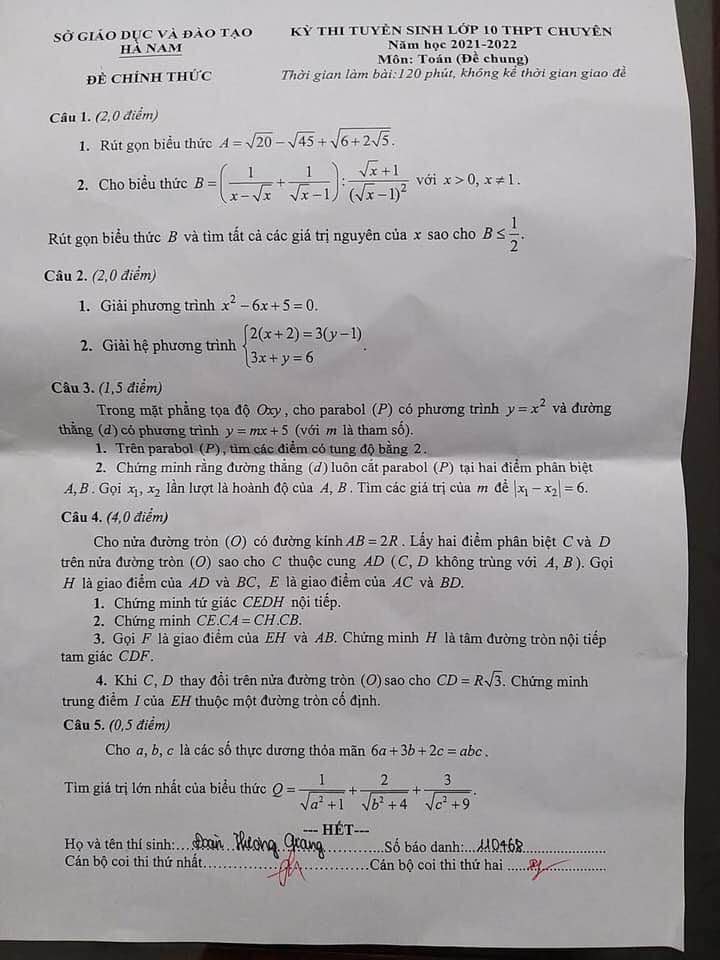Hãy nhập câu hỏi của bạn vào đây, nếu là tài khoản VIP, bạn sẽ được ưu tiên trả lời.

Gọi số học sinh của lớp chuyên toán là x và số học sinh của lớp chuyên tin là y (x;y>0)
Do tổng 2 lớp có 60 học sinh nên: \(x+y=60\)
Chuyển 15 học sinh từ lớp tin sang lớp toán thì số học sinh lớp tin là \(y-15\) và số học sinh lớp toán là \(x+15\)
Do khi đó số học sinh lớp toán gấp 2 lần lớp tin nên: \(x+15=2\left(y-15\right)\Rightarrow x-2y=-45\)
Ta được hệ: \(\left\{{}\begin{matrix}x+y=60\\x-2y=-45\end{matrix}\right.\) \(\Rightarrow\left\{{}\begin{matrix}x=25\\y=35\end{matrix}\right.\)

Câu 4b:
Ta có \(a-\sqrt{a}=\sqrt{b}-b\Leftrightarrow a+b=\sqrt{a}+\sqrt{b}\). (1)
Áp dụng bất đẳng thức Cauchy - Schwarz ta có:
\(a^2+b^2\ge\dfrac{\left(a+b\right)^2}{2};\sqrt{a}+\sqrt{b}\le\sqrt{2\left(a+b\right)}\).
Kết hợp với (1) ta có:
\(a+b\le\sqrt{2\left(a+b\right)}\Leftrightarrow0\le a+b\le2\).
Ta có: \(P\ge\dfrac{\left(a+b\right)^2}{2}+\dfrac{2020}{\left(\sqrt{a}+\sqrt{b}\right)^2}\) (Do \(a^2+b^2\ge\dfrac{\left(a+b\right)^2}{2}\))
\(=\dfrac{\left(a+b\right)^2}{2}+\dfrac{2020}{\left(a+b\right)^2}\) (Theo (1))
\(\Rightarrow P\ge\dfrac{\left(a+b\right)^2}{2}+\dfrac{2020}{\left(a+b\right)^2}\).
Áp dụng bất đẳng thức AM - GM cho hai số thực dương và kết hợp với \(a+b\le2\) ta có:
\(\dfrac{\left(a+b\right)^2}{2}+\dfrac{2020}{\left(a+b\right)^2}=\left[\dfrac{\left(a+b\right)^2}{2}+\dfrac{8}{\left(a+b\right)^2}\right]+\dfrac{2012}{\left(a+b\right)^2}\ge2\sqrt{\dfrac{\left(a+b\right)^2}{2}.\dfrac{8}{\left(a+b\right)^2}}+\dfrac{2012}{2^2}=4+503=507\)
\(\Rightarrow P\ge507\).
Đẳng thức xảy ra khi a = b = 1.
Vậy Min P = 507 khi a = b = 1.
Giải nốt câu 4a:
ĐKXĐ: \(x\geq\frac{-1}{2}\).
Phương trình đã cho tương đương:
\(x^2+2x+1=2x+1+2\sqrt{2x+1}+1\)
\(\Leftrightarrow\left(x+1\right)^2=\left(\sqrt{2x+1}+1\right)^2\)
\(\Leftrightarrow\left(x+1\right)^2-\left(\sqrt{2x+1}+1\right)^2=0\)
\(\Leftrightarrow\left(x+1-\sqrt{2x+1}-1\right)\left(x+1+\sqrt{2x+1}+1\right)=0\)
\(\Leftrightarrow\left(x-\sqrt{2x+1}\right)\left(x+\sqrt{2x+1}+2\right)=0\)
\(\Leftrightarrow\left[{}\begin{matrix}x-\sqrt{2x+1}=0\left(1\right)\\x+\sqrt{2x+1}+2=0\left(2\right)\end{matrix}\right.\).
Ta thấy \(x+\sqrt{2x+1}+2>0\forall x\ge-\dfrac{1}{2}\).
Do đó phương trình (2) vô nghiệm.
Xét phương trình (1) \(\Leftrightarrow x=\sqrt{2x+1}\)
\(\Leftrightarrow\left\{{}\begin{matrix}x\ge0\\x^2=2x+1\end{matrix}\right.\)
\(\Leftrightarrow\left\{{}\begin{matrix}x\ge0\\\left(x-1\right)^2=2\end{matrix}\right.\)
\(\Leftrightarrow\left\{{}\begin{matrix}x\ge0\\\left[{}\begin{matrix}x-1=\sqrt{2}\\x-1=-\sqrt{2}\end{matrix}\right.\end{matrix}\right.\)
\(\Leftrightarrow\left\{{}\begin{matrix}x\ge0\\\left[{}\begin{matrix}x=\sqrt{2}+1>0>-\dfrac{1}{2}\left(TM\right)\\x=-\sqrt{2}+1< 0\left(\text{loại}\right)\end{matrix}\right.\end{matrix}\right.\).
Vậy nghiệm của phương trình là \(x=\sqrt{2}+1\).

a) Ta có : \(x=\sqrt[3]{a+\frac{a+1}{3}\sqrt{\frac{8a-1}{3}}}+\sqrt[3]{a-\frac{a+1}{3}\sqrt{\frac{8a-1}{3}}}\)
\(\Rightarrow x^3=2a+3.\sqrt[3]{a^2-\left(\frac{a+1}{3}\right)^2\left(\frac{8a-1}{3}\right)}.x\)
\(=2a+3\sqrt[3]{a^2-\frac{\left(a^2+2a+1\right)\left(8a-1\right)}{27}}.x\)
\(=2a+3\sqrt[3]{\frac{27a^2-\left(8a^3+15a^2+6a-1\right)}{27}}.x\)
\(=2a+3\sqrt[3]{\frac{-8a^3+12a^2-6a+1}{27}}.x\)
\(=2a+3x.\sqrt[3]{\frac{\left(1-2a\right)^3}{3^3}}=2a+3x.\frac{1-2a}{3}=2a+x\left(1-2a\right)\)
\(\Rightarrow x^2-2a+x\left(2a-1\right)=0\)\(\Leftrightarrow x^3-2a+2ax-x=0\Leftrightarrow x\left(x-1\right)\left(x+1\right)+2a\left(x-1\right)=0\)
\(\Leftrightarrow\left(x-1\right)\left(x^2+x+2a\right)=0\Leftrightarrow\orbr{\begin{cases}x-1=0\\x^2+x+2a=0\end{cases}}\)
Vì \(a>\frac{1}{8}\) nên \(x^2+x+2a>0\Rightarrow\)vô nghiệm.
Vậy x - 1 = 0 => x = 1 thoả mãn x là số nguyên dương.
b) \(\sqrt[3]{x+24}+\sqrt{12-x}=6\) (ĐKXĐ : \(x\le12\))
\(\Leftrightarrow\sqrt[3]{x+24}=6-\sqrt{12-x}\Leftrightarrow x+24=\left(6-\sqrt{12-x}\right)^3\)
\(\Leftrightarrow x+24=6^3-3.6^2.\sqrt{12-x}+3.6.\left(12-x\right)-\left(\sqrt{12-x}\right)^3\)
\(\Leftrightarrow x+24=216-108\sqrt{12-x}+216-18x-\sqrt{12-x}^3\)
\(\Leftrightarrow-19\left(12-x\right)+108\sqrt{12-x}+\sqrt{12-x}^3-180=0\)
Đặt \(y=\sqrt{12-x},y\ge0\) . Phương trình trên tương đương với :
\(-19y^2+108y+y^3-180=0\Leftrightarrow\left(y-10\right)\left(y-6\right)\left(y-3\right)=0\)
=> y = 10 (TM) hoặc y = 6 (TM) hoặc y = 3 (TM)
- Với y = 10 , ta có x = -88 (TM)
- Với y = 6 , ta có x = -24 (TM)
- Với y = 3 , ta có x = 3 (TM)
Vậy tập nghiệm của phương trình : \(S=\left\{-88;-24;3\right\}\)

Câu 1
1) \(A=\sqrt{20}-\sqrt{45}+\sqrt{6+2\sqrt{5}}\)
\(=2\sqrt{5}-3\sqrt{5}+\sqrt{\left(\sqrt{5}\right)^2+2\sqrt{5}+1}\)
\(=-\sqrt{5}+\sqrt{\left(\sqrt{5}+1\right)^2}\)
\(=-\sqrt{5}+\sqrt{5}+1\)
\(=1\)
2) ĐKXĐ: \(x>0;x\ne1\)
\(B=\left(\dfrac{1}{x-\sqrt{x}}+\dfrac{1}{\sqrt{x}-1}\right):\dfrac{\sqrt{x}+1}{\left(\sqrt{x}-1\right)^2}\)
\(=\left(\dfrac{1}{\sqrt{x}\left(\sqrt{x}-1\right)}+\dfrac{1}{\sqrt{x}-1}\right).\dfrac{\left(\sqrt{x}-1\right)^2}{\sqrt{x}+1}\)
\(=\dfrac{1+\sqrt{x}}{\sqrt{x}\left(\sqrt{x}-1\right)}.\dfrac{\left(\sqrt{x}-1\right)^2}{\sqrt{x}+1}\)
\(=\dfrac{\sqrt{x}-1}{\sqrt{x}}\)
\(\Rightarrow B=\dfrac{\sqrt{x}-1}{\sqrt{x}}=\dfrac{1}{2}\)
\(\Leftrightarrow2\left(\sqrt{x}-1\right)=\sqrt{x}\)
\(\Leftrightarrow2\sqrt{x}-2=\sqrt{x}\)
\(\Leftrightarrow2\sqrt{x}-\sqrt{x}=2\)
\(\Leftrightarrow\sqrt{x}=2\)
\(\Rightarrow x=4\left(tmđk\right)\)
Câu 2
1) Phương trình \(x^2-6x+5=0\) có:
\(a+b+c=1-6+5=0\)
\(\Rightarrow\) Phương trình có hai nghiệm phân biệt \(x_1=1\) và \(x_2=\dfrac{c}{a}=5\)
2) \(\left\{{}\begin{matrix}2\left(x+2\right)=3\left(y-1\right)\\3x+y=6\end{matrix}\right.\Leftrightarrow\left\{{}\begin{matrix}2x+4=3y-3\\3x+y=6\end{matrix}\right.\)
\(\Leftrightarrow\left\{{}\begin{matrix}2x-3y=-7\\3x+y=6\end{matrix}\right.\)
\(\Leftrightarrow\left\{{}\begin{matrix}2x-3y=-7\\9x+3y=18\end{matrix}\right.\)
\(\Leftrightarrow\left\{{}\begin{matrix}11x=11\\3x+y=6\end{matrix}\right.\)
\(\Leftrightarrow\left\{{}\begin{matrix}x=1\\3+y=6\end{matrix}\right.\)
\(\Leftrightarrow\left\{{}\begin{matrix}x=1\\y=3\end{matrix}\right.\)


